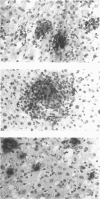Abstract
Immunohistological studies of the murine liver following Leishmania donovani infection have been performed. We describe here the identification of cells expressing a recently defined dendritic cell marker, as detected by monoclonal antibody NLDC 145. Such cells are numerous in the developing inflammatory foci but are not detected individually at any other site in the infected liver. This finding suggests that mature tissue DC are not recruited during infection and that expression of this antigen is under precise microenvironmental control.
Full text
PDF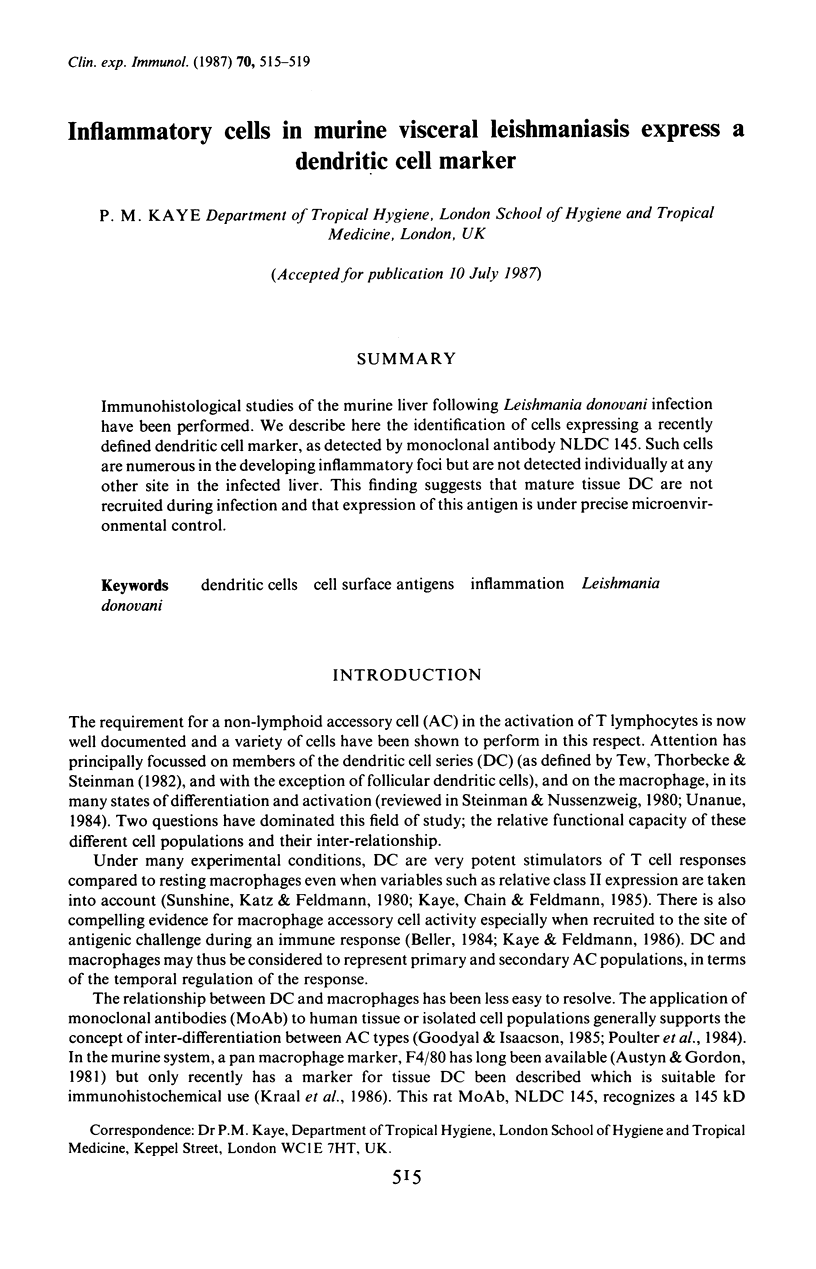
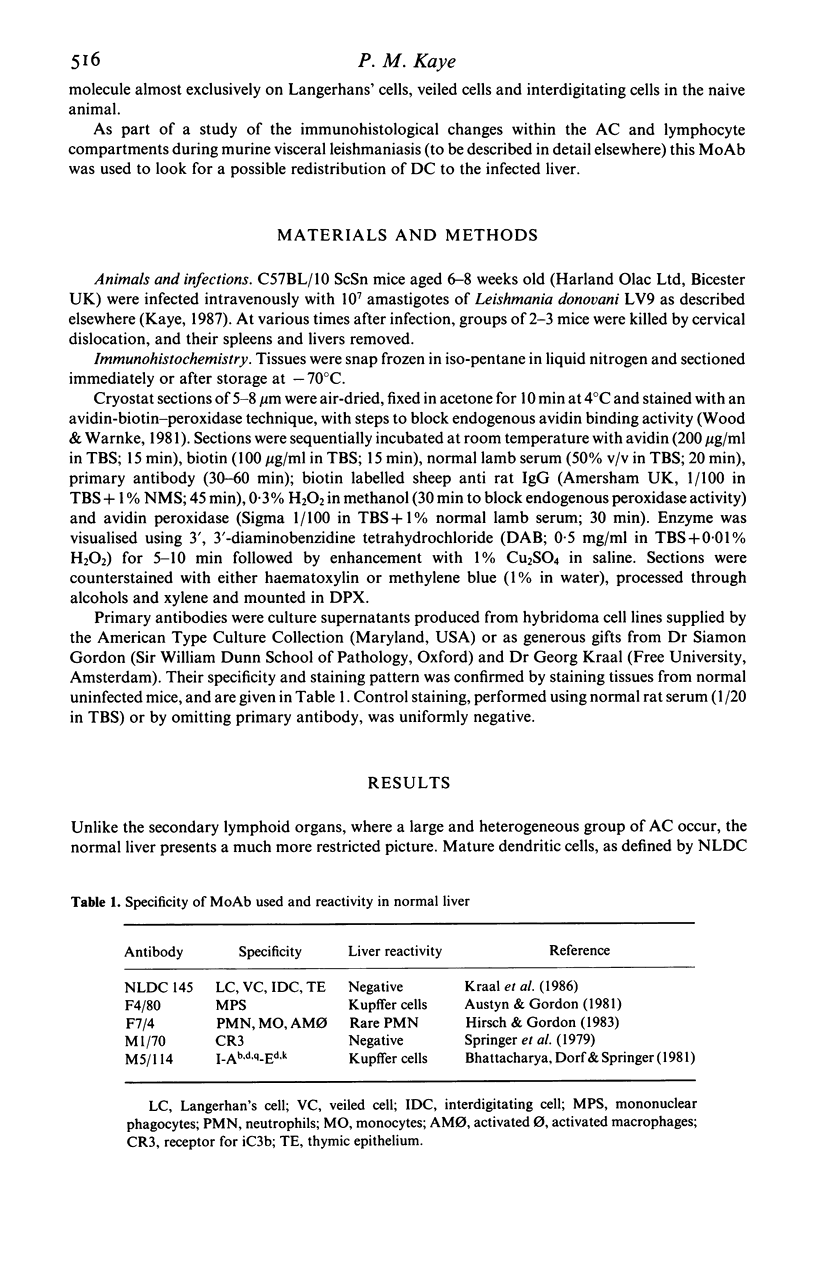
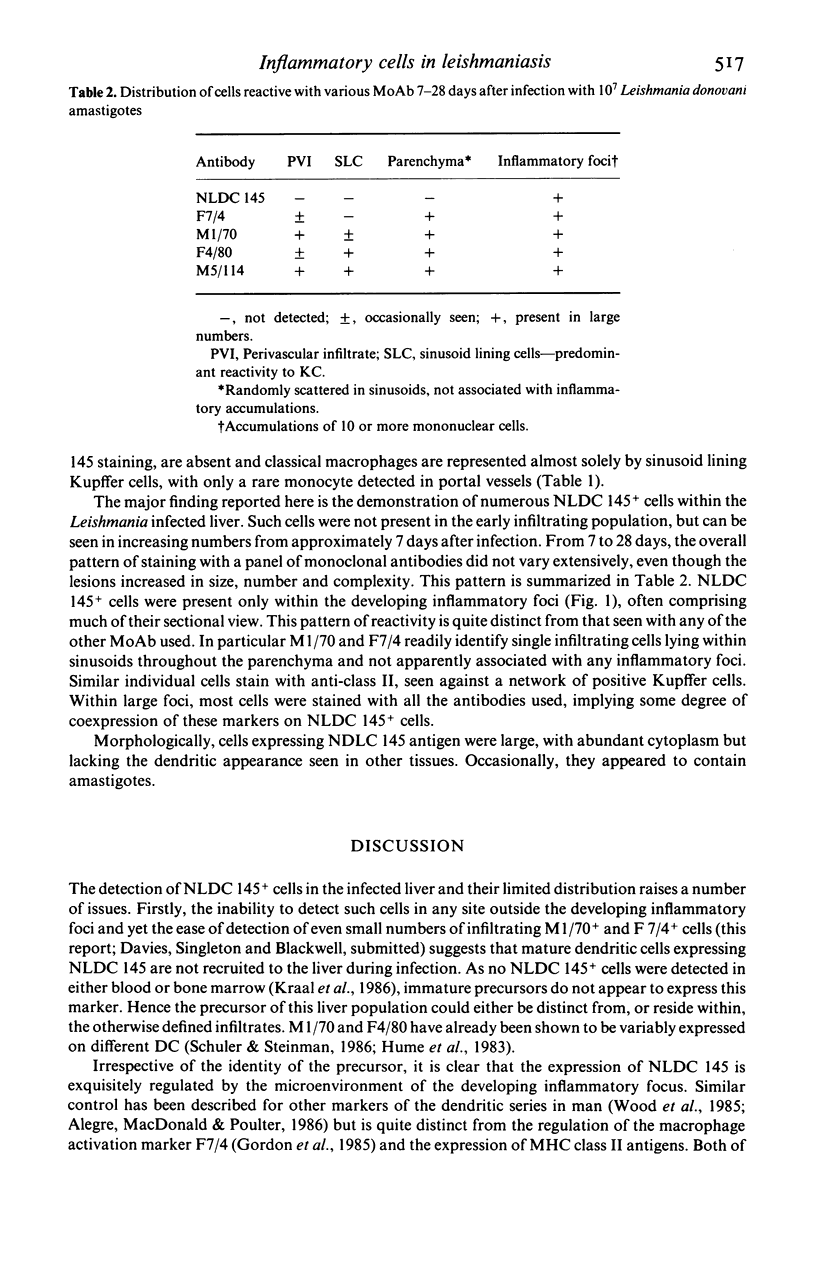
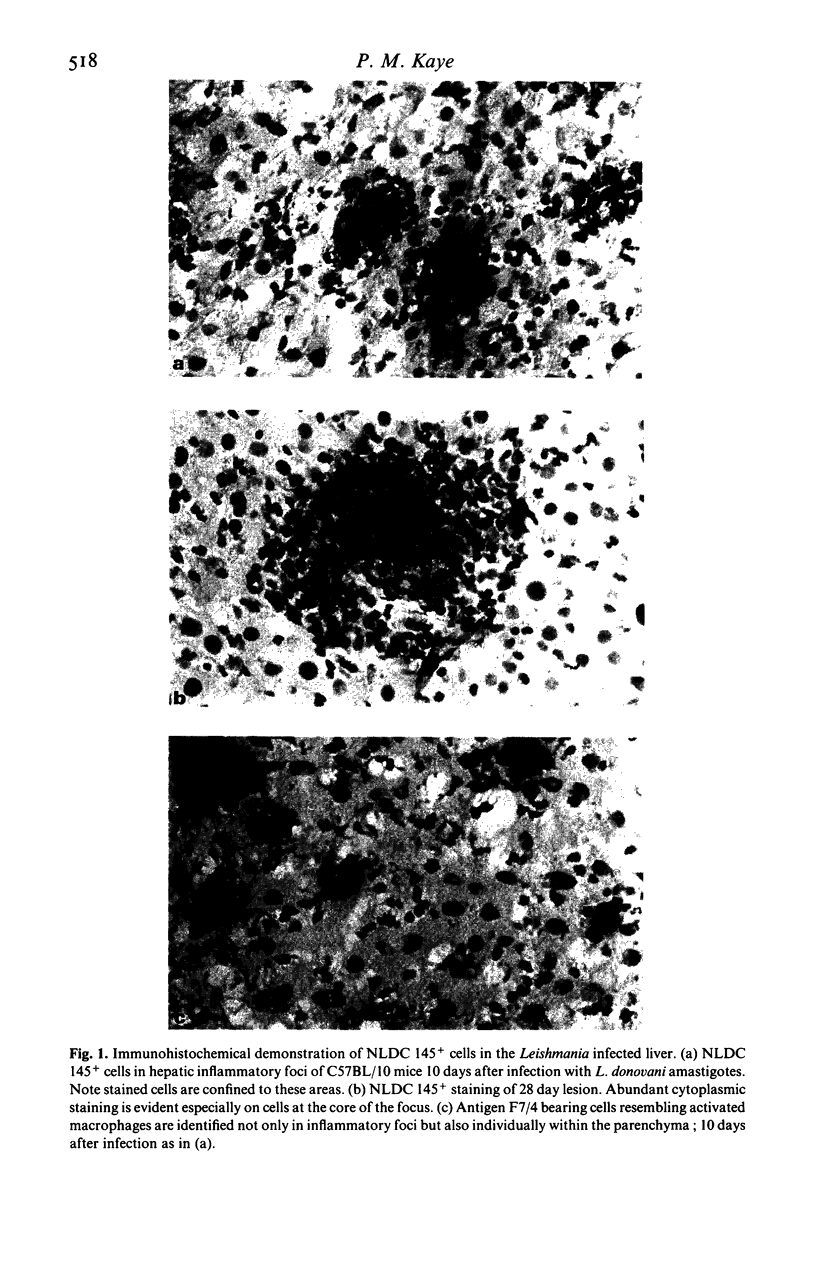
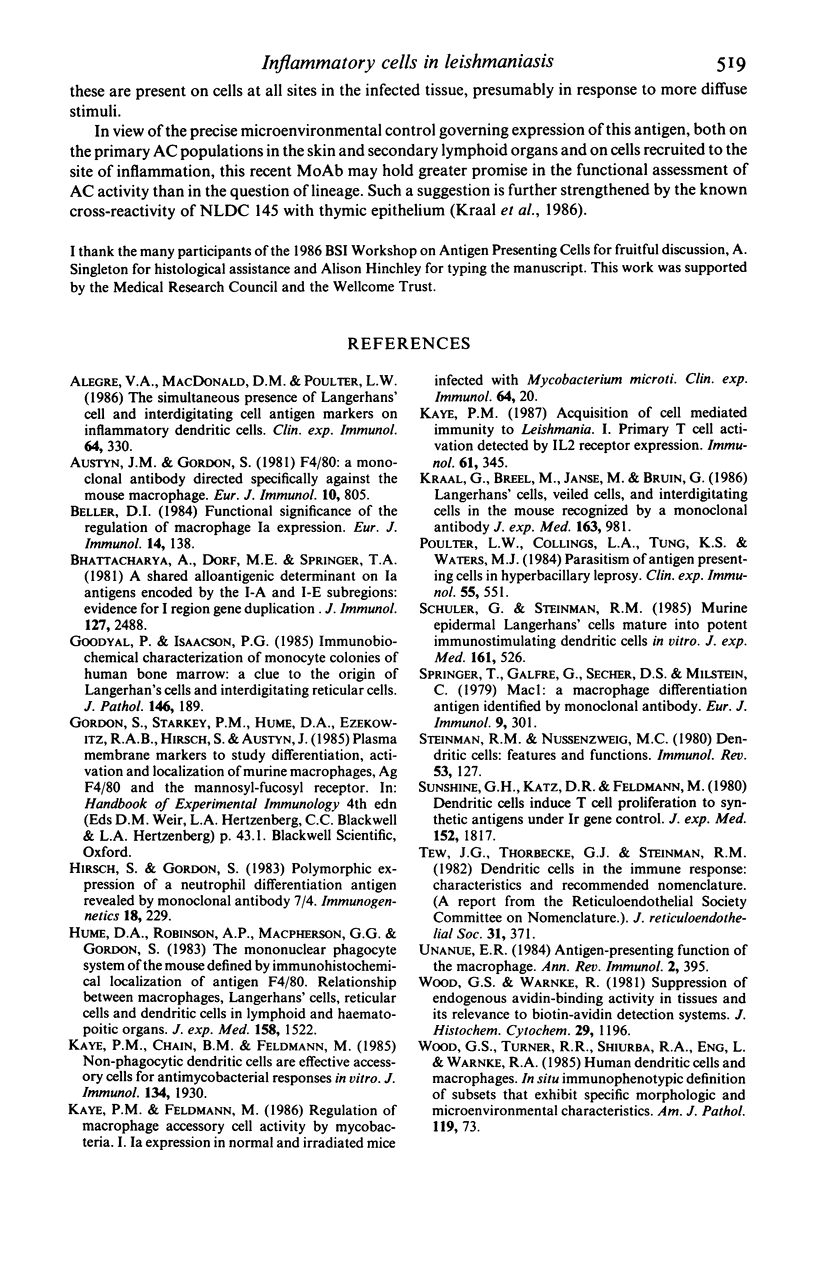
Images in this article
Selected References
These references are in PubMed. This may not be the complete list of references from this article.
- Alegre V. A., MacDonald D. M., Poulter L. W. The simultaneous presence of Langerhans' cell and interdigitating cell antigenic markers on inflammatory dendritic cells. Clin Exp Immunol. 1986 May;64(2):330–333. [PMC free article] [PubMed] [Google Scholar]
- Austyn J. M., Gordon S. F4/80, a monoclonal antibody directed specifically against the mouse macrophage. Eur J Immunol. 1981 Oct;11(10):805–815. doi: 10.1002/eji.1830111013. [DOI] [PubMed] [Google Scholar]
- Beller D. I. Functional significance of the regulation of macrophage Ia expression. Eur J Immunol. 1984 Feb;14(2):138–143. doi: 10.1002/eji.1830140207. [DOI] [PubMed] [Google Scholar]
- Bhattacharya A., Dorf M. E., Springer T. A. A shared alloantigenic determinant on Ia antigens encoded by the I-A and I-E subregions: evidence for I region gene duplication. J Immunol. 1981 Dec;127(6):2488–2495. [PubMed] [Google Scholar]
- Goordyal P., Isaacson P. G. Immunocytochemical characterization of monocyte colonies of human bone marrow: a clue to the origin of Langerhans cells and interdigitating reticulum cells. J Pathol. 1985 Jul;146(3):189–195. doi: 10.1002/path.1711460305. [DOI] [PubMed] [Google Scholar]
- Hirsch S., Gordon S. Polymorphic expression of a neutrophil differentiation antigen revealed by monoclonal antibody 7/4. Immunogenetics. 1983;18(3):229–239. doi: 10.1007/BF00952962. [DOI] [PubMed] [Google Scholar]
- Hume D. A., Robinson A. P., MacPherson G. G., Gordon S. The mononuclear phagocyte system of the mouse defined by immunohistochemical localization of antigen F4/80. Relationship between macrophages, Langerhans cells, reticular cells, and dendritic cells in lymphoid and hematopoietic organs. J Exp Med. 1983 Nov 1;158(5):1522–1536. doi: 10.1084/jem.158.5.1522. [DOI] [PMC free article] [PubMed] [Google Scholar]
- Kaye P. M. Acquisition of cell-mediated immunity to Leishmania. I. Primary T-cell activation detected by IL-2 receptor expression. Immunology. 1987 Jul;61(3):345–349. [PMC free article] [PubMed] [Google Scholar]
- Kaye P. M., Chain B. M., Feldmann M. Nonphagocytic dendritic cells are effective accessory cells for anti-mycobacterial responses in vitro. J Immunol. 1985 Mar;134(3):1930–1934. [PubMed] [Google Scholar]
- Kaye P. M., Feldmann M. Regulation of macrophage accessory cell activity by mycobacteria. I. Ia expression in normal and irradiated mice infected with Mycobacterium microti. Clin Exp Immunol. 1986 Apr;64(1):20–27. [PMC free article] [PubMed] [Google Scholar]
- Kraal G., Breel M., Janse M., Bruin G. Langerhans' cells, veiled cells, and interdigitating cells in the mouse recognized by a monoclonal antibody. J Exp Med. 1986 Apr 1;163(4):981–997. doi: 10.1084/jem.163.4.981. [DOI] [PMC free article] [PubMed] [Google Scholar]
- Schuler G., Steinman R. M. Murine epidermal Langerhans cells mature into potent immunostimulatory dendritic cells in vitro. J Exp Med. 1985 Mar 1;161(3):526–546. doi: 10.1084/jem.161.3.526. [DOI] [PMC free article] [PubMed] [Google Scholar]
- Springer T., Galfré G., Secher D. S., Milstein C. Mac-1: a macrophage differentiation antigen identified by monoclonal antibody. Eur J Immunol. 1979 Apr;9(4):301–306. doi: 10.1002/eji.1830090410. [DOI] [PubMed] [Google Scholar]
- Steinman R. M., Nussenzweig M. C. Dendritic cells: features and functions. Immunol Rev. 1980;53:127–147. doi: 10.1111/j.1600-065x.1980.tb01042.x. [DOI] [PubMed] [Google Scholar]
- Sunshine G. H., Katz D. R., Feldmann M. Dendritic cells induce T cell proliferation to synthetic antigens under Ir gene control. J Exp Med. 1980 Dec 1;152(6):1817–1822. doi: 10.1084/jem.152.6.1817. [DOI] [PMC free article] [PubMed] [Google Scholar]
- Tew J. G., Thorbecke G. J., Steinman R. M. Dendritic cells in the immune response: characteristics and recommended nomenclature (A report from the Reticuloendothelial Society Committee on Nomenclature). J Reticuloendothel Soc. 1982 May;31(5):371–380. [PubMed] [Google Scholar]
- Unanue E. R. Antigen-presenting function of the macrophage. Annu Rev Immunol. 1984;2:395–428. doi: 10.1146/annurev.iy.02.040184.002143. [DOI] [PubMed] [Google Scholar]
- Wood G. S., Turner R. R., Shiurba R. A., Eng L., Warnke R. A. Human dendritic cells and macrophages. In situ immunophenotypic definition of subsets that exhibit specific morphologic and microenvironmental characteristics. Am J Pathol. 1985 Apr;119(1):73–82. [PMC free article] [PubMed] [Google Scholar]
- Wood G. S., Warnke R. Suppression of endogenous avidin-binding activity in tissues and its relevance to biotin-avidin detection systems. J Histochem Cytochem. 1981 Oct;29(10):1196–1204. doi: 10.1177/29.10.7028859. [DOI] [PubMed] [Google Scholar]



